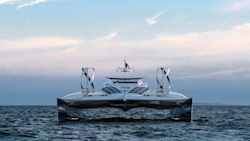The wind, a challenge for maritime transport
Wind may be an infinite resource at sea, but its exploitation remains a challenge for large-scale maritime transport. During the first campaigns around France and in the Mediterranean sea, the Energy Observer tested two vertical-axis wind turbines for producing energy, and a traction kite to reduce energy consumption.

Developed by the ICAM in Nantes, in western France, they were chosen because they are noiseless, for their anti-vibration system, and above all, for their capacity to capture wind from any direction. The aim was to combine different methods of energy production and to add a resource for during the night or in bad weather conditions.
This solution is beneficial when making a stopover and when stationary, but it is ineffective when navigating in head winds of more than 12 or 13 knots. High dunnage means the boat consumes more than the turbines supply. As soon as apparent wind – the sum of the headwind and true wind velocities – arrives head on, the wind turbines produce more, but their aerodynamic drag slows the boat. On the other hand, in a tail wind, they are like part of the rigging but produce little electricity.

One of the 2 vertical axis wind turbines
With a theoretical power output of 1.5 kWh per wind turbine, and despite fulfilling their expectations for noise and vibrations, the vertical-axis wind turbines will be removed in 2019. One will be sent to a stationary project developed for AccorInvest, and the other will be kept at St Malo for future Energy Observer projects.
On an urban building where the force and direction of wind is irregular, these wind turbines, respectful both of the environment and the population, undoubtedly merit further investigation.
The traction kite
Developed by Beyond the Sea, this technology was intended to curb the boat’s energy consumption. It was tested during the Energy Observer’s tour around France.
Both in France and on the Mediterranean, the boat remained close to the coastline and was hence required to change course regularly. Also, a boat ill-suited to manoeuvring this technology presented too many constraints and risks for further testing other wings. The crew still believes this technology can significantly reduce energy consumption with an optimised launching and controlling system. But given weight restrictions and navigation conditions foreseen in Northern Europe, they were obliged to make choices.
To continue to exploit wind energy in the Energy Observer mix, the sailors and engineers decided to completely change the vessel, with the installation of a unique and innovative propulsion system that has never been tested on a boat at such a scale, and which may just revolutionise the future of maritime transport.

